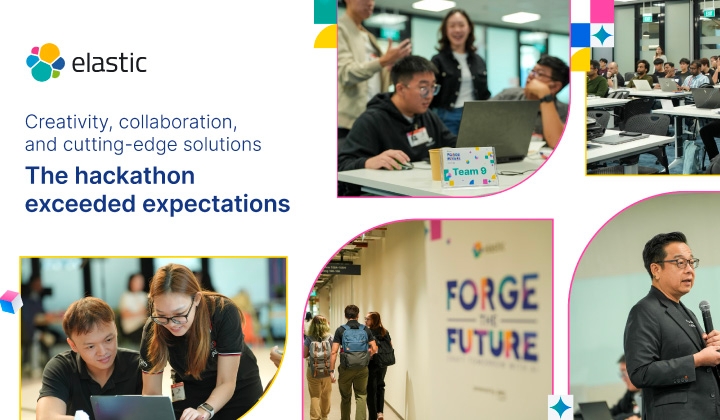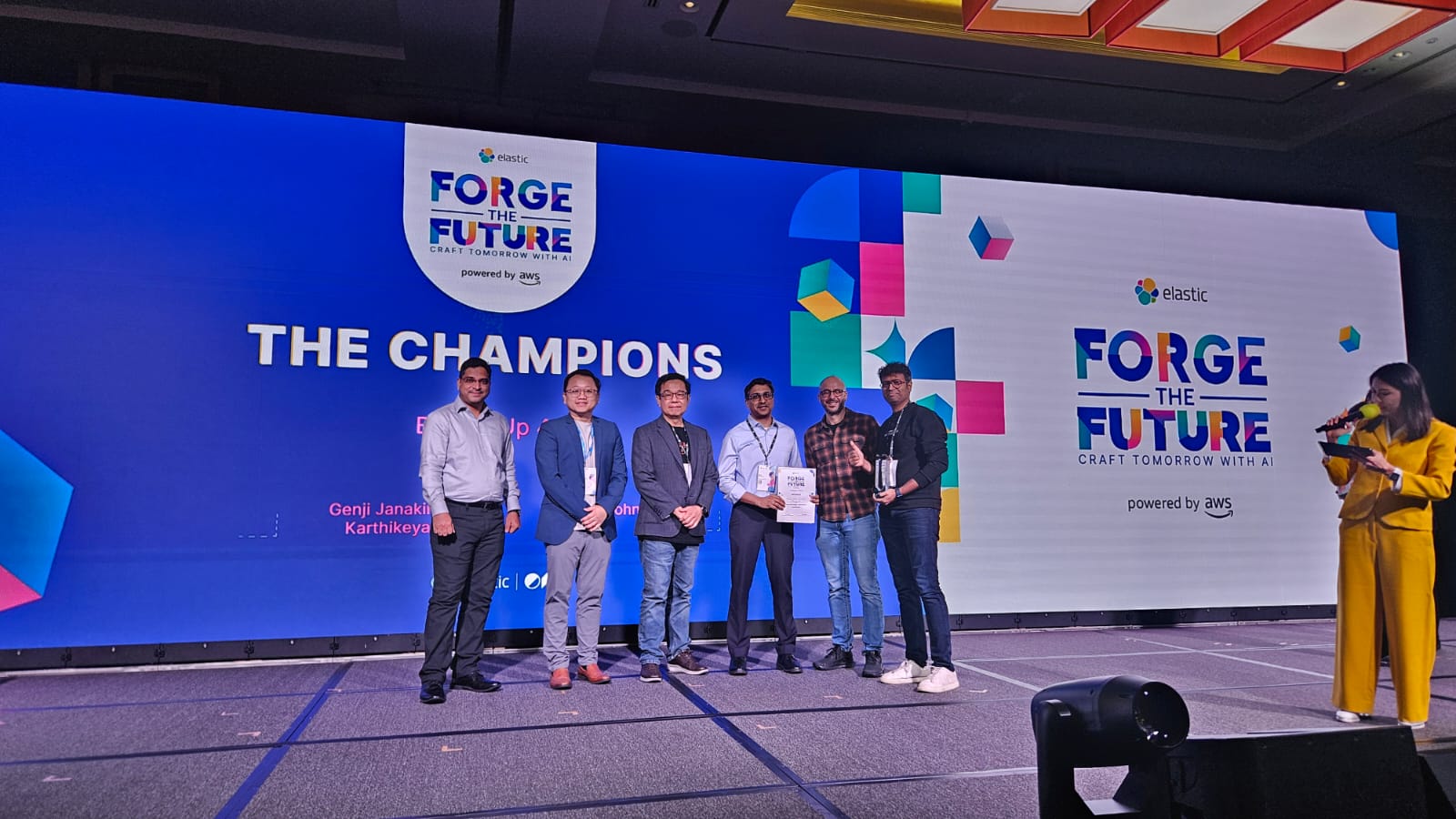Building a better tomorrow with AI: Takeaways from the Forge the Future hackathon

Generative AI (GenAI) applications today often seem limited to frustratingly templated customer service chatbots or simple tools that crunch numbers and other information. We’re still in the early days of GenAI development, use, and adoption, so the technology is still developing to address pressing real-world use cases. But one thing is clear: With the right data at the right time, the possibilities for GenAI are limitless.
At the Forge the Future hackathon organized by Elastic and powered by Amazon Web Services (AWS) in Singapore, 12 teams gathered on February 28, 2025, to compete at creating advanced GenAI applications for use in industries including banking and financial services, manufacturing, healthcare, ecommerce, and the public sector.
Guided by experienced solutions architects, participants were equipped with a suite of tools that power the world’s leading companies. These tools included the Search AI Platform, which combines the precision of search and the intelligence of AI to build transformative applications, and Amazon Bedrock, a fully managed service that offers a choice of high-performing foundation models (FMs) from leading AI companies.
From 13 teams to 3 winners: Where smart ideas meet real-world AI
A strong grasp of the challenge and a well-matched tech stack played to each problem's needs. These teams didn’t just use powerful tools — they made them work together. Their winning solutions combined the strengths of multiple platforms, showing how well-aligned tech choices can lead to smarter outcomes.
Their submissions were assessed by a panel of judges comprising:
- Shay Banon, Founder and CTO, Elastic
- Hock Chuan Lim, Deputy Director, Product Management, AI Products, xDigital, HTX (Home Team Science & Technology Agency)
- Laurence Liew, Director AI Innovation, AI Singapore
- Anil Nallamotu, Head of Global Strategic Partners Solution Architecture, APJ, AWS
Let’s take a closer look at how each of the top three teams turned their big ideas and smart tools into standout solutions.
Use case 1: Generative AI for smarter financial decision-making
Team Buckle Up 4 AI developed the Financial Insights Accelerator, a powerful tool designed to transform complex financial data into actionable insights. Powered by Elasticsearch RAG, Claude 3.7, DeepSeek R1, and Grok 3 (codename Goose), this tool redefines earnings analysis by highlighting key information, enabling deeper follow-up and helping teams make quicker, smarter decisions. Using Elastic’s recent earnings call transcripts and publicly available data, Team Buckle Up 4 AI showcased a demo of their generative AI solution replying to queries about Elastic’s financial performance.
Use case 2: Interpreting diagnostic data with generative AI
Team Squareshift introduced an AI-powered health companion designed to make medical decision-making clearer and more proactive. Using Elasticsearch and Amazon Bedrock, the tool analyzes uploaded health reports, connects them with historical patterns, predicts potential risks, and highlights key trends. Users can visualize results, share insights with doctors, and take early action — all with the goal of living healthier and staying one step ahead.
Use case 3: Generative AI for at-home emergency care
Built by the Singtel Code Crew, Dr. HowsER is an AI-powered at-home emergency care companion designed to deliver personalized health recommendations and actionable advice. Mimicking the flow of a natural doctor-patient conversation, the system integrates IoT data, Elasticsearch, and Amazon Bedrock to provide real-time insights. By offering timely, tailored responses, Dr. HowsER helps users navigate health concerns confidently — reducing the anxiety that often comes with self-diagnosis.
Elastic{ON} Singapore finals


Buckle Up 4 AI emerged as the winner with their Financial Insights Accelerator, underpinned by a clear idea, solid framework and flawless execution. Karthikeyan GJ, a member of the winning team, shared, “Seeing the other teams’ ideas has been enlightening, especially since they cover solutions for various industries like healthcare and fashion. Being able to showcase our ideas to the judges and ultimately win caps off a very positive and eye-opening experience for us.”
When asked about the hackathon and the solutions presented, Laurence Liew opined, “The use cases presented were really interesting and of high quality. I really liked Buckle Up 4 AI’s solution as they demonstrated how organizations can make AI work for you and how it can be used in an innovative way.”
Hock Chuan Lim added, “I found it very impressive that all the participants were able to produce innovative use cases within the three-hour limit. One of the solutions that caught my interest was the one that ingests data from health devices and wearables to generate personalized and actionable insights. I pay more attention to my health as I get older, and I found the use case to be a compelling one.”
Powering AI with search
GenAI will remain a prominent topic in Singapore as organizations transition from pilot projects to real-world technology applications. The country has expressed its goal to become a Smart Nation and lead innovation in AI. In the 2025 budget, the government committed up to S$150 million for a new Enterprise Compute Initiative to help companies adopt artificial intelligence and to provide access to artificial intelligence tools and computing power. There will also be a S$3 billion top-up to the National Productivity Fund that is expected to help Singapore compete in new frontier areas, including artificial intelligence and quantum computing.
As innovation continues, search will be essential for powering GenAI with accurate, relevant data at the right time. Advanced search capabilities like vector search can deliver results based on the underlying meaning of the query, which can include images, video, audio, or text instead of keywords. Other techniques like retrieval augmented generation (RAG) enable organizations to search proprietary data sources and provide context that grounds general output from large language models (LLMs) for more accurate, real-time responses. With LLMs being AI models trained on massive amounts of data to enable them to understand and generate natural language responses, RAG enhances the accuracy and reliability of such models with information retrieved from relevant data sources that are outside their training data sources.
When equipped with these search capabilities, organizations can make full use of their proprietary, highly contextual data, unlocking GenAI’s potential.
Learn more about how AI fuels innovation at Elastic.
The release and timing of any features or functionality described in this post remain at Elastic's sole discretion. Any features or functionality not currently available may not be delivered on time or at all.
In this blog post, we may have used or referred to third party generative AI tools, which are owned and operated by their respective owners. Elastic does not have any control over the third party tools and we have no responsibility or liability for their content, operation or use, nor for any loss or damage that may arise from your use of such tools. Please exercise caution when using AI tools with personal, sensitive or confidential information. Any data you submit may be used for AI training or other purposes. There is no guarantee that information you provide will be kept secure or confidential. You should familiarize yourself with the privacy practices and terms of use of any generative AI tools prior to use.
Elastic, Elasticsearch, ESRE, Elasticsearch Relevance Engine and associated marks are trademarks, logos or registered trademarks of Elasticsearch N.V. in the United States and other countries. All other company and product names are trademarks, logos or registered trademarks of their respective owners.